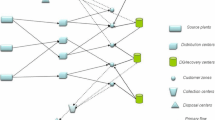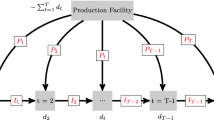Abstract
Disruptions rarely occur in supply chains, but their negative financial and technical impacts make the recovery process very slow. In this paper, we propose a capacitated supply chain network design (SCND) model under random disruptions both in facility and transportation, which seeks to determine the optimal location and types of distribution centers (DC) and also the best plan to assign customers to each opened DC. Unlike other studies in the extent literature, we use new concepts of reliability to model the strategic behavior of DCs and customers at the network: (1) Failure of DCs might be partial, i.e. a disrupted DC might still be able to serve with a portion of its initial capacity (2) The lost capacity of a disrupted DC shall be provided from a non-disrupted one and (3) The lost capacity fraction of a disrupted DC depends on its initial investment amount in the design phase.
In order to solve the proposed model optimally, a modified version of Benders’ Decomposition (BD) is applied. This modification tackles the difficulties of the BD’s master problem (MP), which ultimately improves the solution time of BD significantly. The classical BD approach results in low density cuts in some cases, Covering Cut Bundle (CCB) generation addresses this issue by generating a bundle of cuts instead of a single cut, which could cover more decision variables of the MP. Our inspiration to improve the CCB generation led to a new method, namely Maximum Density Cut (MDC) generation. MDC is based on the observation that in some cases CCB generation is cumbersome to solve in order to cover all decision variables of the MP rather than to cover part of them. Thus the MDC method generates a cut to cover the remaining decision variables which are not covered by CCB. Numerical experiments demonstrate the practicability of the proposed model to be promising in the SCND area, also the modified BD approach decreases the number of BD iterations and improves the CPU times, significantly.












Similar content being viewed by others
Notes
Except Peng et al. (2011).
Lim et al. (2010) defined that disruptions occur at unreliable DCs, and reliable DCs are the outsourcing ones which are secured against disruption and assumed to be uncapacitated.
For example, consider a company which intends to supply its customers located in three different area zones. This must be planned in three particular modes: truck, rail and air in which the experience shows that many accidents (disruptions) have happened so far. Thus, this transportation strategy seems excessively risky. One proper safe strategy is to get assistance from outsources (similar to reliable DCs in Lim et al. 2010) in order to prevent the massive cost that company may be charged with; this is what we call safe transportation mode.
If safe transportation mode in the primary assignment is used, there will be no need to use the secondary assignment, because the safe mode is also safe in disruption situation.
The CCB method which is presented in this subsection is for the case of optimally cut, for feasibility cut refer to Saharidis et al. (2010).
Hereafter we compile our investigation for medium and large sizes 80 and 120 by means of instances P24 and P28 in Table 2, respectively.
References
Altner, D. S., Ergun, O., & Uhan, N. A. (2010). The maximum flow network interdiction problem: valid inequalities, integrality gaps, and approximability. Operations Research Letters, 38(1), 33–38.
Andreas, A. K., & Smith, J. C. (2009). Decomposition algorithms for the design of a non simultaneous capacitated evacuation tree network. Networks, 53(2), 91–103.
Benders, J. F. (1962). Partitioning procedures for solving mixed-variables programming problems. Numerische Mathematik, 4(1), 238–252.
Berman, O., Krass, D., & Menezes, M. (2007). Facility reliability issues in network p-median problems: strategic centralization and co-location effects. Operations Research, 55(2), 332–350.
Berman, O., Krass, D., & Menezes, M. (2009). Locating facilities in the presence of disruptions and incomplete information. Decision Sciences, 40(4), 845–868.
Chopra, S., & Sodhi, M. S. (2004). Managing risk to avoid supply-chain breakdown. MIT Sloan Management Review, 46(1), 53–61.
Chopra, S., Reinhardt, G., & Mohan, U. (2007). The importance of decoupling recurrent and disruption risks in a supply chain. Naval Research Logistics, 54(5), 544–555.
Church, R. L., & Scaparra, M. P. (2006). Protecting critical assets: the R-interdiction median problem with fortification. Geographical Analysis, 39(2), 129–146.
Church, R. L., Scaparra, M. P., & Middleton, R. S. (2004). Identifying critical infrastructure: the median and covering facility interdiction problem. Annals of the Association of American Geographers, 94(3), 491–502.
Colbourn, C. (1987). The combinatorics of network reliability. New York: Oxford University Press.
Conejo, A. J., Castillo, E., Minguez, R., & Garcia-Bertrand, R. (2006). Decomposition techniques in mathematical programming. In Engineering and science applications. Berlin: Springer.
Cordeau, J. F., Soumis, F., & Desrosiers, J. (2000). A Benders decomposition approach for the locomotive and car assignment problem. Transportation Science, 34(2), 133–149.
Cordeau, J. F., Pasin, F., & Solomon, M. M. (2006). An integrated model for logistics network design. Annals of Operations Research, 144(1), 59–82.
Cote, G., & Laughton, M. (1984). Large-scale mixed integer programming: Benders-type heuristics. European Journal of Operational Research, 16, 327–333.
Craighead, C. W., Blackhurst, J., Rungtusanatham, M. J., & Handfield, R. B. (2007). The severity of supply chain disruptions: Design characteristics and mitigation capabilities. Decision Sciences, 38(1), 131–156.
Cui, T., Ouyang, Y., & Shen, Z.-J. (2010). Reliable facility location design under the risk of disruptions. Operations Research, 58(4), 998–1011.
Drezner, Z. (1987). Heuristic solution methods for two location problems with unreliable facilities. Journal of Operations Research Society, 38(6), 509–514.
Elkins, D., Handfield, R. B., Blackhurst, J., & Craighead, C. W. (2005). 18 ways to guard against disruption. Supply Chain Management Review, 9(1), 46–53.
Kleindorfer, P. R., & Saad, G. (2005). Managing disruption risks in supply chains. Production and Operations Management, 14(1), 53–68.
Klibi, W., Martel, A., & Guitouni, A. (2010). The design of robust value-creating supply chain networks: a critical review. European Journal of Operational Research, 203(2), 283–293.
Kraiselburd, S., Narayanan, V. G., & Raman, A. (2004). Contracting in a supply chain with stochastic demand and substitute products. Production and Operations Management, 13(1), 46–62.
Kaut, M., Wallace, S. W., Vladimirou, H., & Zenios, S. (2007). Stability analysis of portfolio management with conditional value-at-risk. Quantitative Finance, 7(4), 397–409.
Kulkarni, S. S., Magazine, M. J., & Raturi, A. S. (2004). Risk pooling advantages of manufacturing network configuration. Production and Operations Management, 13(2), 186–199.
Lee, S. D. (2001). On solving unreliable planar location problems. Computers & Operations Research, 28(4), 329–344.
Li, X., & Ouyang, Y. (2010). A continuum approximation approach to reliable facility location design under correlated probabilistic disruptions. Transportation Research. Part B, 44(4), 535–548.
Liberatore, F., Scaparra, M. P., & Daskin, M. S. (2011). Analysis of facility protection strategies against an uncertain number of attacks: the stochastic R-interdiction median problem with fortification. Computers & Operations Research, 38(1), 357–366.
Liberatore, F., Scaparra, M. P., & Daskin, M. S. (2012). Hedging against disruptions with ripple effects in location analysis. Omega, 40, 21–30.
Lim, M., Daskin, M., Bassamboo, A., & Chopra, S. (2010). A facility reliability problem: formulation, properties and algorithm. Naval Research Logistics, 57(1), 58–70.
Magnanti, T., & Wong, R. (1981). Accelerating Benders decomposition algorithmic enhancement and model selection criteria. Operations Research, 29, 464–484.
Martinez-de-Albeniz, V., & Simchi-Levi, D. (2005). A portfolio approach to procurement contracts. Production and Operations Management, 14(1), 90–114.
McDaniel, D., & Devine, M. (1977). A modified Benders partitioning algorithm for mixed integer programming. Management Science, 24, 312–319.
Mohebbi, E. (2004). A replenishment model for the supply-uncertainty problem. International Journal of Production Economics, 87, 25–37.
Oke, A., & Gopalakrishnan, M. (2009). Managing disruptions in supply chains: a case study of a retail supply chain. International Journal of Production Economics, 181, 168–174.
Papadakos, N. (2008). Practical enhancements to the Magnanti-Wong method. Operations Research Letters, 36(4), 444–449.
Parlar, M. (1997). Continuous review inventory problem with random supply interruptions. European Journal of Operational Research, 99, 366–385.
Parlar, M., & Berkin, D. (1991). Future supply uncertainty in EOQ models. Naval Research Logistics, 38, 107–121.
Peng, P., Snyder, L. V., Lim, A., & Liu, Z. (2011). Reliable logistics networks design with facility disruptions. Transportation Research. Part B. doi:10.1016/j.trb.2011.05.022.
Qi, L., Shen, Z.-J., & Snyder, L. V. (2010). The effect of supply disruptions on supply chain design decisions. Transportation Science, 44(2), 274–289.
Rei, W., Gendreau, M., Cordeau, J. F., & Soriano, P. (2006). Accelerating Benders decomposition by local branching. In: Hybrid methods and branching rules in combinatorial optimization, Montreal, 2006.
Saharidis, G. K. D., & Ierapetritou, M. G. (2010). Improving Benders decomposition using maximum feasible subsystem (MFS) cut generation strategy. Computers & Chemical Engineering, 8(34), 1237–1245.
Saharidis, G. K. D., Minoux, M., & Dallery, Y. (2009). Scheduling of loading and unloading of crude oil in a refinery using event-based discrete time formulation. Computers & Chemical Engineering, 33(8), 1413–1426.
Saharidis, G. K. D., Minoux, M., & Ierapetritou, M. G. (2010). Accelerating Benders method using covering cut bundle generation. International Transactions in Operational Research, 17(2), 221–237.
Saharidis, G. K. D., Boile, M., & Theofanis, S. (2011). Initialization of the Benders master problem using valid inequalities applied to fixed-charge network problems. Expert Systems with Applications. doi:10.1016/j.eswa.2010.11.075.
Scaparra, M. P., & Church, R. L. (2008). A bi level mixed-integer program for critical infrastructure protection planning. Computers & Operations Research, 35(6), 1905–1923.
Sherali, H. F., & Lunday, B. J. (2011). On generating maximal non dominated Benders cuts. Annals of Operations Research. doi:10.1007/s10479-011-0883-6.
Shier, D. R. (1991). Network reliability and algebraic structures. Oxford: Clarendon Press.
Shooman, M. L. (2002). Reliability of computer systems and networks: fault tolerance, analysis, and design. New York: Wiley.
Snyder, L. V., & Daskin, M. S. (2005). Reliability models for facility location: the expected failure cost case. Transportation Science, 39(3), 400–416.
Snyder, L. V., & Daskin, M. S. (2006). Stochastic p-robust location problems. IIE Transactions, 38(11), 971–985.
Snyder, L. V., Scaparra, M. P., Daskin, M. S., & Church, R. L. (2006). Planning for disruptions in supply chain networks. In: Tutorials in operations research INFORMS 2006 (pp. 234–257).
Tang, C. S. (2006). Perspectives in supply chain risk management. International Journal of Production Economics, 103, 451–488.
Tomlin, B. (2006). On the value of mitigation and contingency strategies for managing supply chain disruption risks. Management Science, 52(5), 639–657.
Tomlin, B., & Wang, Y. (2005). On the value of mix flexibility and dual sourcing in unreliable newsvendor networks. Manufacturing & Service Operations Management, 7(1), 37–57.
Wagner, S. M., & Bode, C. (2006). An empirical investigation into supply chain vulnerability. Journal of Purchasing and Supply Management, 12(6), 301–312.
Zakeri, G., Philpott, A. B., & Ryan, D. M. (1998). Inexact cuts in benders decomposition. SIAM Journal on Optimization, 10(3), 643–657.
Author information
Authors and Affiliations
Corresponding author
Rights and permissions
About this article
Cite this article
Azad, N., Saharidis, G.K.D., Davoudpour, H. et al. Strategies for protecting supply chain networks against facility and transportation disruptions: an improved Benders decomposition approach. Ann Oper Res 210, 125–163 (2013). https://doi.org/10.1007/s10479-012-1146-x
Published:
Issue Date:
DOI: https://doi.org/10.1007/s10479-012-1146-x




